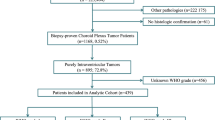Abstract
Purpose
Cribriform neuroepithelial tumor (CRINET) is a provisional category of intraventricular tumors, sharing similarities with AT/RTs, and there is a lack of data about its pathology, prognosis, and surgical approaches in the literature. We have been challenged to describe the surgical approach to a rare case of CRINET and describe the intraoperative features since none has been described before. Surgical resection and chemotherapy hold a great importance of favorable prognosis.
Methods
Twenty-month-old male with intraventricular tumor underwent transcallosal intraventricular tumor resection and endoscopic intraventricular second look stages. The tumor was initially considered choroid plexus carcinoma and histopathological results pointed CRINET. The patient also received Ommaya reservoir for intrathecal chemotherapy employment. The patient’s preoperative and postoperative MRI scans and tumor’s pathological features are described with a brief history of the disease in the literature.
Results
Lack of SMARCB1 gene immunoreactivity and presence of cribriform non-rhabdoid trabecular neuroepithelial cells led to the CRINET diagnosis. The surgical technique helped us to approach directly into the third ventricle and perform total resection and intraventricular lavage. The patient recovered without any perioperative complications and is consulted pediatric oncology for further treatment planning.
Conclusion
With our limited knowledge on the matter, our presentation may provide an inside to the course and progress of the CRINET as a very rare tumor and may help to set a basis for future investigations focused on its clinical and pathological features. Long courses of follow-up periods are required for establishing treatment modules and assessing the responses to surgical resection techniques and chemotherapy protocols.



Similar content being viewed by others
Data availability
The authors confirm that the data supporting the findings of this study are available within the article and its supplementary materials.
References
Rushing EJ, Cooper PB, Quezado M et al (2007) Subependymoma revisited: clinicopathological evaluation of 83 cases. J Neurooncol 85(3):297–305
Louis DN, Perry A, Reifenberger G et al (2016) The 2016 World Health Organization classification of tumors of the central nervous system: a summary. Acta Neuropathol (Berl) 131:803–820
Suh DY, Mapstone T (2001) Pediatric supratentorial intraventricular tumors. Neurosurg Focus 10(6):1–14
Dunham C (2015) Uncommon pediatric tumors of the posterior fossa: pathologic and molecular features. Childs Nerv Syst 31:1729–1737
Johann PD, Hovestadt V, Thomas C et al (2017) Cribriform neuroepithelial tumor: molecular characterization of a SMARCB1-deficient non-rhabdoid tumor with favorable long-term outcome. Brain Pathol 27(4):411–418
Jackson EM, Sievert AJ, Gai X et al (2009) Genomic analysis using high-density single nucleotide polymorphism-based oligonucleotide arrays and multiplex ligation-dependent probe amplification provides a comprehensive analysis of INI1/SMARCB1 in malignant rhabdoid tumors. Clin Cancer Res 15(6):1923–1930
Chi SN, Zimmerman MA, Yao X et al (2009) Intensive multimodality treatment for children with newly diagnosed CNS atypical teratoid rhabdoid tumor. J Clin Oncol 27(3):385
Hasselblatt M, Oyen F, Gesk S et al (2009) Cribriform neuroepithelial tumor (CRINET): a nonrhabdoid ventricular tumor with INI1 loss and relatively favorable prognosis. J Neuropathol Exp Neurol 68(12):1249–1255
Park JY, Kim E, Kim DW, Chang HW, Kim SP (2012) Cribriform neuroepithelial tumor in the third ventricle: a case report and literature review. Neuropathology 32(5):570–576
Ibrahim GM, Huang A, Halliday W et al (2011) Cribriform neuroepithelial tumour: novel clinicopathological, ultrastructural and cytogenetic findings. Acta Neuropathol (Berl) 122:511–514
Tauziède-Espariat A, Guerrini-Rousseau L, Puget S et al (2021) A novel case of cribriform neuroepithelial tumor: a potential diagnostic pitfall in the ventricular system. Pediatr Blood Cancer 68(9):e29037
Ruland V, Hartung S, Kordes U, Wolff JE, Paulus W, Hasselblatt M (2014) Choroid plexus carcinomas are characterized by complex chromosomal alterations related to patient age and prognosis. Genes Chromosomes Cancer 53(5):373–380
Arnold MA, Stallings-Archer K, Marlin E et al (2013) Cribriform neuroepithelial tumor arising in the lateral ventricle. Pediatr Dev Pathol 16(4):301–307
Gessi M, Japp AS, Dreschmann V et al (2015) High-resolution genomic analysis of cribriform neuroepithelial tumors of the central nervous system. J Neuropathol Exp Neurol 74(10):970–974
Cai C (2021) SWI/SNF deficient central nervous system neoplasms. In: Seminars in Diagnostic Pathology. Vol 38. Elsevier 167–174
Author information
Authors and Affiliations
Corresponding author
Ethics declarations
Ethics approval
All procedures performed in studies involving human participants were in accordance with the ethical standards of the institutional and/or national research committee (name of institute/committee) and with the 1964 Helsinki declaration and its later amendments or comparable ethical standards, and informed consent was obtained from all individual participants included in the study.
This study protocol was reviewed and approved by the Ethical Committee of Ankara University, approval number I11-678–22.
Consent for publication
A written informed consent was obtained from patient’s mother and father as his legal guardians, for publication and scientific documentation of his clinical information and imaging studies.
Conflict of interest
The authors declare no competing interests.
Additional information
Publisher's Note
Springer Nature remains neutral with regard to jurisdictional claims in published maps and institutional affiliations.
Rights and permissions
Springer Nature or its licensor (e.g. a society or other partner) holds exclusive rights to this article under a publishing agreement with the author(s) or other rightsholder(s); author self-archiving of the accepted manuscript version of this article is solely governed by the terms of such publishing agreement and applicable law.
About this article
Cite this article
Mete, E.B., Eray, H.A., Orhan, O. et al. Transcallosal and endoscopic hybrid approach to a rare entity of pediatric intraventricular tumors—cribriform neuroepithelial tumor: a case report and literature review. Childs Nerv Syst 39, 1123–1129 (2023). https://doi.org/10.1007/s00381-023-05897-1
Received:
Accepted:
Published:
Issue Date:
DOI: https://doi.org/10.1007/s00381-023-05897-1




